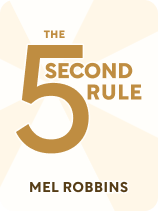

This article is an excerpt from the Shortform book guide to "The 5 Second Rule" by Mel Robbins. Shortform has the world's best summaries and analyses of books you should be reading.
Like this article? Sign up for a free trial here.
Are you looking for The 5 Second Rule quotes by Mel Robbins? What are some of the most noteworthy passages worth revisiting?
In The 5 Second Rule, Mel Robbins offers tips to help you integrate the habit of the 5 Second Rule into your life. Robbins uses a combination of her own coping techniques, testimonials from others, and neuroscientific research to support her claims that the 5 Second Rule can help you.
Take a look at the best The 5 Second Rule quotes to get a better sense of the book.
Quotes From The 5 Second Rule by Mel Robbins
Do you feel stuck and dissatisfied with your life? Do you struggle to take steps toward self-improvement, live in the moment, or overcome procrastination? If so, life coach and motivational speaker Mel Robbins offers a solution. In The 5 Second Rule, Robbins explains how you can assert agency over your life using a single method: counting down from five to one over the course of five seconds and acting when you reach one.
The following The 5 Second Rule quotes highlight some of the key ideas.
“There’s one thing that is guaranteed to increase your feelings of control over your life: a bias toward action.”
Robbins notes that the 5 Second Rule gives you a tool to overcome resistance and complete tasks—especially non-habitual tasks—that previously felt impossible due to anxiety, depression, or lack of motivation.
Mental health struggles and lack of motivation often result in us overthinking our actions. According to Robbins, it takes just five seconds for the brain to convince us not to do something if it isn’t already part of our routine. The brain triggers this overthinking to protect us from possible unknown negative consequences of non-habitual action: When we have the impulse to do something that isn’t part of our routine, the brain generates reasons why that new action may lead to negative outcomes.
For example, let’s say you usually stay home and watch Netflix on your days off work. However, you’ve been feeling stressed lately and know you’d benefit from being active—say, by playing tennis with your friends. You have a gut feeling telling you to change your routine and exercise, but you stop to think about it for just a few seconds and your brain starts overthinking: “What if I can’t play as well as I used to and I feel embarrassed? What if I look silly in my workout clothes?” Because you don’t normally exercise and your brain fears that doing so might have negative consequences, you think of all the reasons you shouldn’t exercise despite knowing you should. The thoughts ultimately prevent you from playing tennis with your friends.
However, if you use Robbins’s 5 Second Rule, you count down from five to one when you first notice yourself overthinking. You can then quickly act on your gut feeling before overthinking overwhelms and stops you. For example, when you use the Rule and reach one, you can interrupt your overthinking and send your friends a text message inviting them to play tennis with you later that day. This confirms your plans and makes it more difficult for your brain to talk you out of following through.
“Life is gritty and hard and then suddenly it is brilliant and amazing.”
Robbins claims that when you’re feeling worried, intentionally thinking of something you’re grateful for can help you calm down. Thinking about the good things in your life causes your brain to release dopamine, naturally soothing your mood by altering your brain chemistry.
To implement this method, Robbins suggests counting backward from five to one, then thinking of something you’re grateful for. For example, if you’re worried about losing touch with a friend who’s moving away and you find yourself imagining the end of your friendship, count down from five to one and, when you get to one, think of how grateful you are to have spent so much time with this friend.
“It’s not the big moves that change everything—it’s the smallest ones in your everyday life that do.”
Robbins specifically argues that making yourself get out of bed 30 minutes earlier than you normally would changes your life for the better. Robbins provides two tips for successfully using the Rule to get out of bed. First, put your alarm clock in the room next to your bedroom (close enough that you can still hear it from your bed). When your alarm goes off, use the Rule, get up when you count down to one, then leave the room to turn off the alarm. Doing so discourages you from going back to sleep after your alarm goes off: Once you’re already out of bed, you might as well stay out.
(Shortform note: If you can’t put your alarm clock in another room (perhaps you want to avoid disturbing others, or you live in a one-room apartment), an alternative could be to buy a unique alarm clock designed for heavy sleepers. Examples include a clock on wheels that you have to chase around the room to silence, a dumbbell-shaped clock that makes you do a set of lifts, or even a wristwatch that delivers electric shocks until you rouse yourself with jumping jacks.)
Second, Robbins asserts that you should never hit “snooze” on your alarm clock. Research shows that going back to sleep for 15 minutes after snoozing your alarm triggers a new sleep cycle. The brain can’t complete this cycle in the few minutes of extra sleep you’re getting, and when you get out of bed for good, the part of your brain that controls focus, willpower, and decisions isn’t completely rested due to this interrupted cycle. This makes you feel groggy for up to four hours.

———End of Preview———
Like what you just read? Read the rest of the world's best book summary and analysis of Mel Robbins's "The 5 Second Rule" at Shortform.
Here's what you'll find in our full The 5 Second Rule summary:
- Why counting down from five to one will help you assert agency over your life
- The different ways you can use the 5-Second Rule
- How to figure out what your passions are and work toward them






